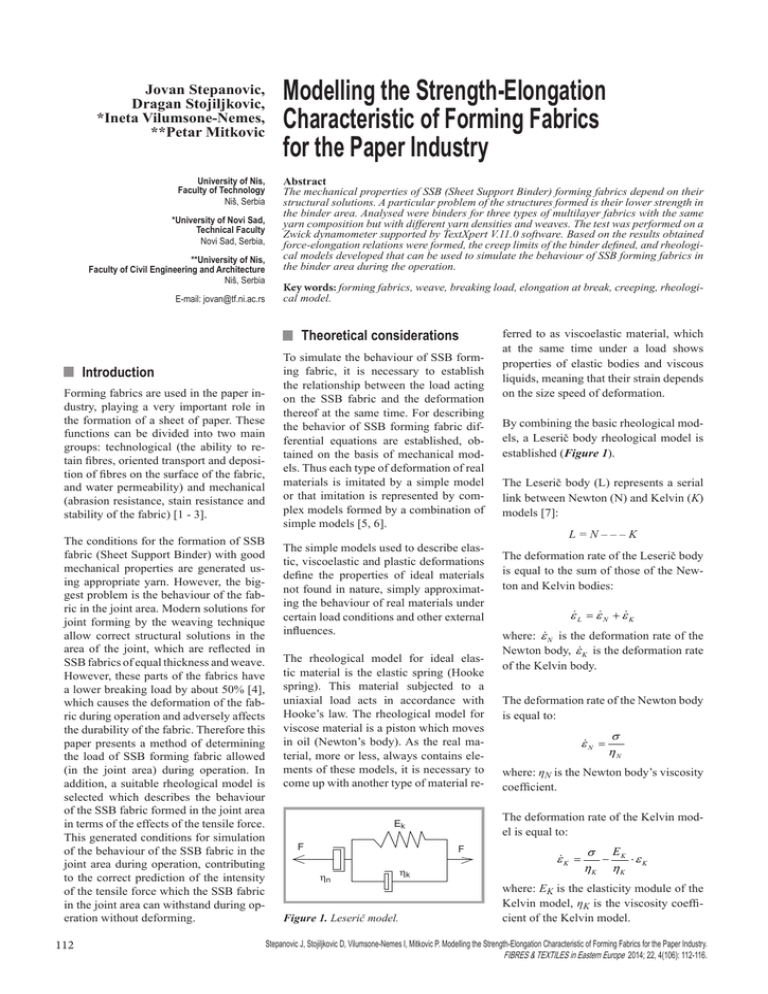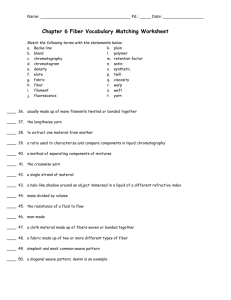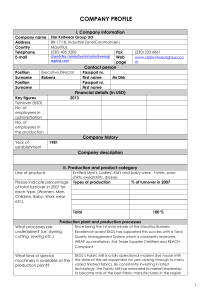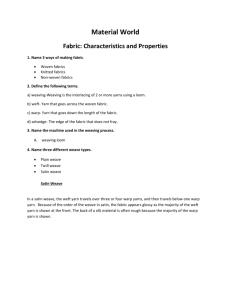Modelling the Strength-Elongation Characteristic of Forming Fabrics for the Paper Industry Jovan Stepanovic,
advertisement

Jovan Stepanovic, Dragan Stojiljkovic, *Ineta Vilumsone-Nemes, **Petar Mitkovic University of Nis, Faculty of Technology Niš, Serbia *University of Novi Sad, Technical Faculty Novi Sad, Serbia, **University of Nis, Faculty of Civil Engineering and Architecture Niš, Serbia E-mail: jovan@tf.ni.ac.rs Modelling the Strength-Elongation Characteristic of Forming Fabrics for the Paper Industry Abstract The mechanical properties of SSB (Sheet Support Binder) forming fabrics depend on their structural solutions. A particular problem of the structures formed is their lower strength in the binder area. Analysed were binders for three types of multilayer fabrics with the same yarn composition but with different yarn densities and weaves. The test was performed on a Zwick dynamometer supported by TextXpert V.11.0 software. Based on the results obtained force-elongation relations were formed, the creep limits of the binder defined, and rheological models developed that can be used to simulate the behaviour of SSB forming fabrics in the binder area during the operation. Key words: forming fabrics, weave, breaking load, elongation at break, creeping, rheological model. n Theoretical considerations nIntroduction Forming fabrics are used in the paper industry, playing a very important role in the formation of a sheet of paper. These functions can be divided into two main groups: technological (the ability to retain fibres, oriented transport and deposition of fibres on the surface of the fabric, and water permeability) and mechanical (abrasion resistance, stain resistance and stability of the fabric) [1 - 3]. The conditions for the formation of SSB fabric (Sheet Support Binder) with good mechanical properties are generated using appropriate yarn. However, the biggest problem is the behaviour of the fabric in the joint area. Modern solutions for joint forming by the weaving technique allow correct structural solutions in the area of the joint, which are reflected in SSB fabrics of equal thickness and weave. However, these parts of the fabrics have a lower breaking load by about 50% [4], which causes the deformation of the fabric during operation and adversely affects the durability of the fabric. Therefore this paper presents a method of determining the load of SSB forming fabric allowed (in the joint area) during operation. In addition, a suitable rheological model is selected which describes the behaviour of the SSB fabric formed in the joint area in terms of the effects of the tensile force. This generated conditions for simulation of the behaviour of the SSB fabric in the joint area during operation, contributing to the correct prediction of the intensity of the tensile force which the SSB fabric in the joint area can withstand during operation without deforming. 112 To simulate the behaviour of SSB forming fabric, it is necessary to establish the relationship between the load acting on the SSB fabric and the deformation thereof at the same time. For describing the behavior of SSB forming fabric differential equations are established, obtained on the basis of mechanical models. Thus each type of deformation of real materials is imitated by a simple model or that imitation is represented by complex models formed by a combination of simple models [5, 6]. The simple models used to describe elastic, viscoelastic and plastic deformations define the properties of ideal materials not found in nature, simply approximating the behaviour of real materials under certain load conditions and other external influences. The rheological model for ideal elastic material is the elastic spring (Hooke spring). This material subjected to a uniaxial load acts in accordance with Hooke’s law. The rheological model for viscose material is a piston which moves in oil (Newton’s body). As the real material, more or less, always contains elements of these models, it is necessary to come up with another type of material re- F F η hn n Figure 1. Leserič model. ηk hk By combining the basic rheological models, a Leserič body rheological model is established (Figure 1). The Leserič body (L) represents a serial link between Newton (N) and Kelvin (K) models [7]: L=N–––K The deformation rate of the Leserič body is equal to the sum of those of the Newton and Kelvin bodies: ε L = ε N + ε K where: εN is the deformation rate of the Newton body, εK is the deformation rate of the Kelvin body. The deformation rate of the Newton body is equal to: ε N = σ ηN where: ηN is the Newton body’s viscosity coefficient. The deformation rate of the Kelvin model is equal to: E Ekk FF ferred to as viscoelastic material, which at the same time under a load shows properties of elastic bodies and viscous liquids, meaning that their strain depends on the size speed of deformation. ε K = σ EK − ⋅εK ηK ηK where: EK is the elasticity module of the Kelvin model, ηK is the viscosity coefficient of the Kelvin model. Stepanovic J, Stojiljkovic D, Vilumsone-Nemes I, Mitkovic P. Modelling the Strength-Elongation Characteristic of Forming Fabrics for the Paper Industry. FIBRES & TEXTILES in Eastern Europe 2014; 22, 4(106): 112-116. After some mathematical operations the following expression is obtained for the rate of deformation of the Leserič body: ε = where: τr = (ηN + ηK)/EK relaxation time. The stress-elongation dependence has the form: joined with special binding weft wires (01, 02). The fabric has an upper warp (2, 4, ..., 24) which binds with the upper weft in a plain weave (04). The lower warp (1, 3, ..., 23) binds with the lower weft (03) in a six-wire satin weave. The binding weft has the same density as the weft of the upper fabric. At the same time it alternately binds with the upper warp in plain weave and with the lower warp in an irregular twelve-wire satin weave. SSB fabric 1V2P51 (Figure 4) is formed on a weaving machine as double fabric joined with special binding weft wires (1, 2). The fabric has an upper warp (2, 4, ..., 24) which binds with the upper weft in plain weave (4 and 6). The lower warp (1, 3, ...., 23) binds with the lower weft (3 and 5) in a six-wire satin weave. The binding weft has the same density as the weft of the upper fabric. At the same time it alternately binds with the upper warp in plain weave and with the lower warp in an irregular twelve-wire satin weave (Binder weft and weft of the upper fabric bind in a proportion of 2:2). E EK lo σ σ EK 1 dt ( ⋅ 1 -⋅ texp + − ⋅ exp − K ⋅ t ⋅ ε o + ⋅σ∫ σ= η ⋅ exp ⋅ ε ) N ⋅σ η N ηk η K ηK ηK ηK 100 ⋅v ⋅ τ r E E 1 ⋅ exp − K ⋅ t ⋅ ε o + ⋅ ∫ σ ⋅ exp K ⋅ t dt ηK η η η K K K where: ε0 is the initial relative elongation. EK Differentiation by the time and rearrangement of the previous expression gives a differential equation of the rheological model in the following form: ε ⋅η K + ε ⋅ E K ⋅η K = σ (η N + η K ) + σ ⋅ E K As ε = const and ε = 0, this differential equation can be represented in the form: EK ⋅t + η N ⋅ σ ηK + ηN The integration constant, C, is determined from the initial conditions t = 0, σ = 0. The voltage-time dependence, after determining the integration constant, has the form: σ = - C ⋅ exp - t σ = η N ⋅ σ ⋅ 1 - exp ( ) τr Figure 2. 1V1P41 binder cross section. where: lo - starting test tube’s length, v – test speed n Materials and methods All three forming SSBs have a commercial application. SSB fabric 1V1P41 (Figure 2) is formed on a weaving machine as double fabric joined by special binding weft wires (01, 02). The fabric has an upper warp (02, 04, ..., 20) which binds to the upper weft (04) in the plain weave. The lower warp (01, 03, ..., 19) binds with the lower weft (03) in a fivewire satin weave. The binder weft is two times denser (the number of wires in cm) in regard to the warp of the upper fabric. At the same time it alternately binds with the upper warp in plain weave and with the lower warp in an irregular ten-wire satin weave. Tables 1 and 2 (see page 114) contain the characteristics of the monofilament yarns and warp and weft densities of the SSB fabrics applied. SSB fabric 1V1P51 (Figure 3) is formed on a weaving machine as double fabric Figure 3. 1V1P51 binder cross section. 1500 1250 1000 750 500 F'(ε) 250 0 -500 Figure 4. 1V2P51 binder cross section. FIBRES & TEXTILES in Eastern Europe 2014, Vol. 22, 4(106) F'''(ε) F''(ε) -250 0 2 4 6 8 10 Figure 5. First, second and third derivatives of function F (ε). 113 Table 1. Monofilament yarn characteristics. Position Composition Diameter, mm Linear Breaking load, density, dtex cN/tex Elongation at break, % Upper warp 0.13 185 55.4 18.1 Lower warp 0.21 479 61.6 10.9 0.14 214 42.9 24.9 Lower weft 0.25 679 45.3 24.9 Lower weft 0.25 562 55.2 45.7 0.13 152 63.9 37.7 PES Upper weft PA 6.6 Binding weft pb = pε = Table 2. Warp and weft densities (number of wires in 1 cm) – [cm-1] Position Composition 1V1P41, cm-1 1V1P51, cm-1 1V2P51, cm-1 Upper warp 30.5 30 30.5 Lower warp 30.5 30 30.5 19.5 21.5 23.5 Lower weft 9.75 10.75 11.75 Lower weft 9.75 10.75 11.75 39.0 21.5 23.5 PES Upper weft PA 6.6 Binding weft Testing of the tensile strength and elongation at break of the binders in the weft direction was performed on a Zwick dynamometer. Dimensions of the strips were 350 × 50 mm and after tearing the measuring width was 40 mm. The distance between the clamps was 200 mm. that the binders can handle without deformation. n Results and discussion The experiments were carried out under the following conditions: n Pre-load force - 10 N n Pre load speed - 20 mm/min n Test speed - 80 mm/min. Investigation results of the breaking load and elongation at break testing for thermo stable SSB fabrics (thermal stabilisation provides length and width stability of the SSB fabric) are shown in Table 3, and those of the investigation of the breaking load, elongation at break, creeping limit forces and creeping elongation in the region of joints are given in Table 4. In addition, based on the curve F - ε, the values of forces and relative elongation were determined at the creeping limit in the binder area (Fcr), whereby the first permanent deformation was generated, which occurs beyond the elasticity limit. It is determined numerically at the point of the local minimum of the second derivative of the curve F - ε, where F’’’(ε) = 0 [8, 9] (Figure 5, binder 1V1P41). These data can be used to predict the limit load The breaking characteristics of 1V1P41 fabric in the joint area are lower than those of thermo-stable fabric, where the reduction in the breaking load is 48.13%, and elongation at break - 49.41%. The reduction in the tensile force in the area of the joint of 1V1P51 fabric is 60.33% and in elongation- 64.36%. In 1V2P51 fabric, the breaking load in the joint area is lower by 49.35% and elongation at break by 51.24% compared to thermo-stable fabrics. Table 3. Breaking load and elongation at break of thermo stable SSB fabrics. 1V1P41 1V1P51 1V2P51 Fmax, N εmax, % Fmax, N εmax, % Fmax, N εmax, % X 3976 17.81 3786 18.07 3908 19.36 S 127.4 1.12 23.6 0.45 67.7 0.95 Cv 3.2 6.29 0.62 2.29 1.73 4.91 Table 4. Mechanical characteristics of joints. 1V1P41 114 Fmax, N εmax, % X 2063 9.01 S 74.8 0.37 Cv 3.63 4.11 Fcr, N 744 1V1P51 εcr, % 2.01 Fmax, N εmax, % 1502 6.44 72.8 0.42 4.85 6.52 Fcr, N 338 1V2P51 εcr, % 0.78 Fmax, N εmax, % 1979 9.44 94.9 0.81 4.79 8.58 The percentage of the reduced breaking load pb and elongation pe in the joint area is determined by the Equation: Fcr, N εcr, % 362 0.85 Fb − Fbjbj Fb ⋅100 ,[%] ε b −eεbjbj ⋅ 100 ,[%] εb where: Fb - breaking load of SSB fabric, Fbj - breaking load of SSB fabric in the joint area, eb - elongation at break of SSB fabric, ebj - elongation at break of SSB fabric in the joint area. In 1V1P41 fabric the joint area may be subjected to a strain of up to 744 N without suffering the first permanent deformation, while the intensity of force of the first permanent deformation in the other two fabrics in the joint area is much lower. The value of forces at the creeping limit of 1V1P41 fabric is 18.71% compared to the breaking load of thermostable fabric, and 36.07% compared to the breaking load of the fabric in the joint area. Based on the results obtained, it can be concluded that the properties of SSB fabric depend on the mechanical properties of the yarns for warp and weft applied, then the density of warp and weft wires and finally on the weave (construction) of the SSB forming fabric. For 1V1P41 fabric, which shows the best mechanical properties, the reverse side is a five-end satin weave (Figure 2), unlike fabrics 1V1P51 and 1V2P51, where it is of a six-end satin weave (Figures 3 and 4). The quotient of the number of variations and weave repeat [10] is more favorable for five-end satin, which, among other things, is the reason for the results obtained. In addition to the more suitable weave of the lower fabric, SSB 1V1P41 has a greater density of binding weft wires, which also contributes to the improved mechanical properties of the SSB fabric, compared to the other two analyses of SSB fabrics. SSB fabric 1V2P51 has better mechanical properties in comparison to SSB fabric 1V1P51,which is a result of the greater density of warp and weft wires of SSB 1V2P51 compared to SSB 1V1P51. Figure 6 shows the measured and calculated values of F(ε) and the relative error of the model for fabric 1V1P41 in the joint area. FIBRES & TEXTILES in Eastern Europe 2014, Vol. 22, 4(106) 5 Measured values Measured values 2250 4 3 By model By model 2000 Relativeerror error, % Relative (%) 1750 Force,(N) N Force 1500 1250 1000 750 500 250 2 1 0 -1 -2 -3 -4 -5 -6 -7 0 0 1 2 3 4 5 6 7 8 9 10 11 -1 0 1 2 3 4 5 6 7 8 9 10 11 Elongation, % Elongation (%) Elongation, % Elongation (%) Figure 6. Values of F(ε) measured and calculated (a) and relative error (b) for 1V1P41 fabric in the joint area according to Leserič model. Measured values Measured values By model By model 1600 12 1400 8 Relative error error, % Relative (%) Force,(N) N Force 1200 1000 800 600 400 4 0 -4 -8 200 0 0 1 2 3 4 5 6 7 8 9 10 -12 11 0 1 2 3 4 5 6 7 8 9 10 11 Elongation, % Elongation (%) Elongation, (%) % Elongation Figure 7. Values of F(ε) measured and calculated (a) and relative error (b) for 1V1P51 fabric in the joint area according to Leserič model. 6 2250 4 Measured values Measured values By model By model 2 Relative error, % Relative error (%) 2000 1750 Force, N Force (N) 1500 1250 1000 750 500 -2 -4 -6 -8 -10 250 0 0 -12 0 2 4 6 8 Elongation,(%) % Elongation 10 12 0 2 4 6 8 10 12 Elongation, Elongation (%)% Figure 8. Values of F(ε) measured and calculated (a) and relative error (b) for 1V2P51 fabric in the joint area according to the Leserič model. FIBRES & TEXTILES in Eastern Europe 2014, Vol. 22, 4(106) 115 Table 5. Model coefficients. 1V1P41 1V1P51 1V2P51 a b a b a b 2528 0.17 1486 0.35 2275 0.19 Table 6. Young’s modulus and coefficient of dynamic viscosity. 1V1P41 1V1P51 η E η E η 867,600 1,945,000 1,028,000 1,143,000 851,000 1,750,000 In Figure 7, given are the measured and calculated values of F(ε) and the relative error of the model for 1V1P51 fabric in the joint area. Figure 8 shows the measured and calculated values of F(ε) and the relative error of the model for fabric 1V2P51 in the joint area. Based on the experimental data and relation obtained by approximation from the rheological model, the following Equation was obtained: s = a (1 - e-b .e) Model coefficients ‘a’ and ‘b’ are given in Table 5. Relation between coefficients “a” and “b” and physical characteristics are given in expressions: E = 2000 a b and h = a/v where: E - Young’s modulus in N/m2, η - coefficient of dynamic viscosity in Ns2/m, v - speed of clamp during testing in m/s. Equation s = a (1 - e-b .e) can be written in the form: E ⋅ε 2000⋅η ⋅v σ =η ⋅ v 1- e . Table 6 shows the values of Young’s module of elasticity and the coefficient of dynamic viscosity obtained based on the rheological model which was established by experimental data. Analysing the relative error of the model, it can be confirmed that the maximum relative deviation of actual values from the theoretical is negligent. Thus it can be concluded that the model correctly describes the rheological behaviour of SSB fabric in the joint area when subjected to elongation. Also it can be concluded that the model describes the behaviour of 116 1V2P51 E the material up to the creeping limit very well, which is particularly important for the development of design methods for SSB fabrics in the area of the joint. nConclusions The mechanical properties of SSB forming fabric depend on the mechanical properties of the yarns for the warp and weft applied, then the density of warp and weft wires, and finally on the weaves (constructions) of the SSB. SSB fabrics of the same composition (warp PES, weft PES and PA, weft binder PA) were analysed, but of different wire density and weave. On the basis of research results, it is concluded that forming SSB fabrics with applied five-wire satin weave on the reverse side of the fabric should take precedence over SSB fabrics with a six-wire satin weave applied. Also SSB fabrics have better mechanical properties with greater densities of warp and weft wires applied. The mechanical properties of all three types of fabrics deteriorate after the completion of joints, which indicates that the research should continue to find optimal solutions regarding the structure and design of SSB fabrics in the area of the joint. Based on the results obtained a rheological model is developed that can be used to simulate the behaviour of SSB fabrics in the area of the joint during operation. Also it can be concluded that the model correctly describes the behaviour of the material up to the fabric’s creeping limit in the region of the joint. References 1.Dasgupta S, Ray N. Designing of Forming Fabrics considering paper making aspects IPPTA Journal 2009; 4: 103108. 2. Zheng P, Ding X, Yang J, Chen R. Transverse Vibration of Papermaking Felt. FIBRES & TEXTILES in Eastern Europe 2010; 18, 3, 80: 106-108. 3. Kaurov PV, Kokushin NN, Tikhonov AA, Kaurov PV. Mathematical modeling for paper stock drainage at hydrofoils of wire part of paper making machine. International Journal of Industrial Engineering and Management (IJIEM) 2011; 1: 27-31. 4. Skoko I, Stepanović J, Petrović V, Stanković M, Stamenković M. Uticaj strukturnih i konstruktivnih parametara formirajućih SSB sita na njihova svojstva. Savremene tehnologije 2012; 1: 52-57. 5. Ward IM, Sweeney J. An introduction to the mechanical properties of solid polymers. Second Edition, John Wiley and sons, West Sussex, 2004. 6. Banik K. Effect of mold temperature on short and long-term mechanical properties of PBT. eXPRESS Polymer Letter 2008; 2: 111–117. 7. Stojiljkovic D, Petrovic V, Djurovic M. Rheological modeling of yarn elongation. Tekstil 2007; 9: 551-561. 8. Stepanovic J, Milutinovic Z, Petrovic V, Pavlovic M. Influence of relative density on deformation characteristics of fabrics in plain weave. Indian Journal of Fibre & Textile Research 2009; 1: 76-81. 9. Petrović V, Stepanović J, Skoko I, Stankovic M, Stamenkovic M. Analysis of Deformation Characteristics of SSB Forming Sieves. In: 14th Romanian Textiles and Leather Conference. Sinaia, Romania, 6. – 8. 9. 2012: 158-165. 10. Stepanovic J, Zafirova K, Milutinović Z, Petrović V. Design of fabric breaking characteristics. Macedonian Journal of Chemistry and Chemichal Engineering 2007; 1: 45-55. 11. Wu DF, Zhou CX, Fan X, Mao DL, Bian Z. Linear rheological behavior and thermal stability of poly(butylene terephthalate)/epoxy/clay ternary nano composites. Polymer Degradation and Stability 2005; 3: 511-520. 12.Chow WS. Tensile and thermal properties of poly-butyleneterephtalate)/ organo-montmorillonite nano composites. Malaysian Polymer Journal 2008; 1: 1-13. 13. Hashemi S. Temperature dependence of work of fracture parameters in polybutylene-terephthalate (PBT). Polymer Engineering & Science 2000; 6: 1435–1446. 14.Pegoretti A, Gorigato A, Penati A. Tensile mechanical response of polyethylene-clay nano composites. eXPRESS Polymer Letter 2007; 1: 123–132. Received 07.11.2013 Reviewed 26.12.2013 FIBRES & TEXTILES in Eastern Europe 2014, Vol. 22, 4(106)






